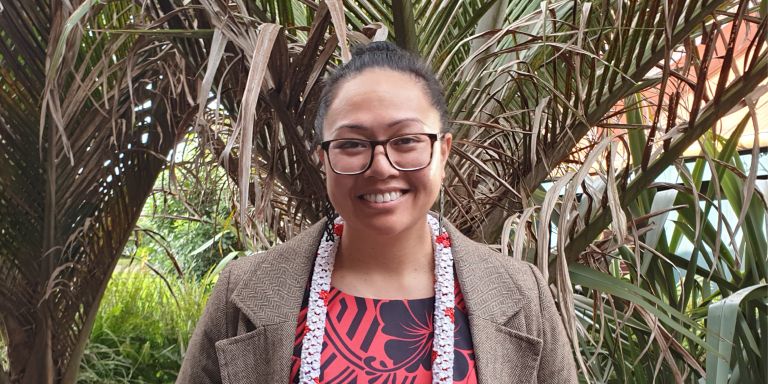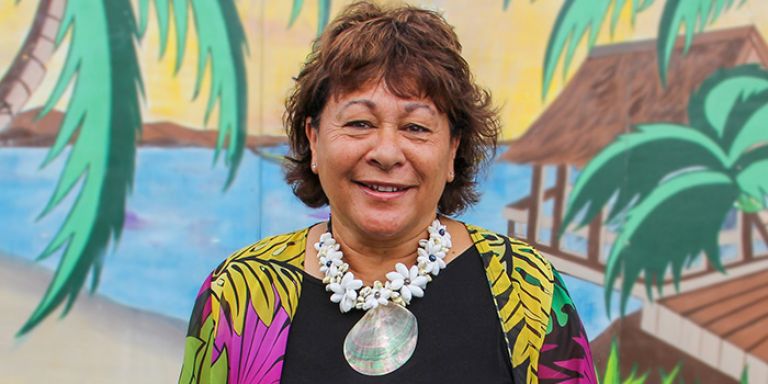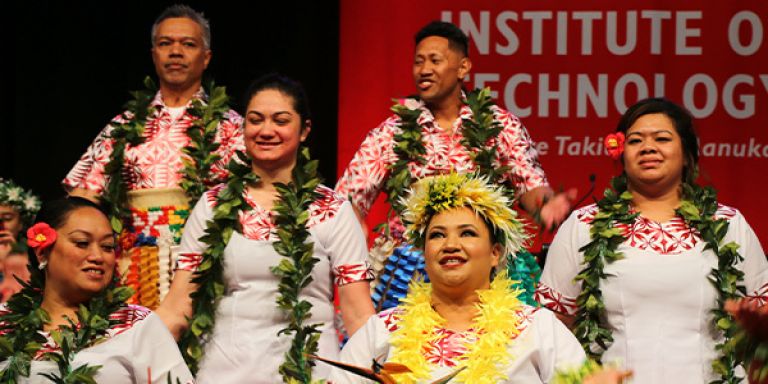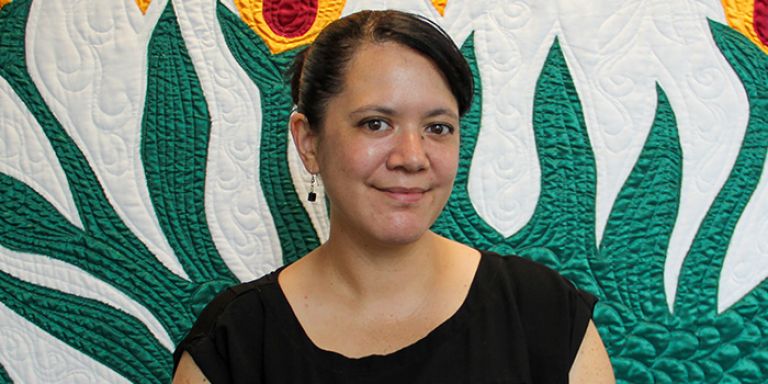We have courses available in Gagana Samoa, Lea Faka-Tonga and Cook Islands Māori.
- If you’re Pasifika – reconnect with your identity and culture through your language. Improve your ability to communicate with people in your family, community and workplace.
- If you work with people from the Pacific nations and want to develop your communication skills – discover how learning a language and its cultural practices can connect you with people at your work and in our community.
“In order to understand one’s culture, you must understand their language”
Dr Edmond Fehoko, Te Tomokanga Postdoctoral Fellow, University of Auckland
Programmes
- Pasifika cultural intelligence workshop
- Less than six months
- Pasifika Community Centre, MIT Ōtara
- Throughout the year
- New Zealand Certificate in Pacific Language (Cook Islands Māori) (Level 3)
- One year
- MIT Ōtara
- February
- New Zealand Certificate in Pacific Language (Tonga) (Level 3)
- One year
- MIT Ōtara
- February
- New Zealand Certificate in Pacific Language (Samoa) (Level 3)
- One year
- MIT Ōtara
- February, July
- New Zealand Certificate in Pacific Language (Cook Islands Māori) (Level 4)
- One year
- MIT Ōtara
- July
- New Zealand Certificate in Pacific Language (Tonga) (Level 4)
- One year
- MIT Ōtara
- July
- New Zealand Certificate in Pacific Language (Samoa) (Level 4)
- One year
- MIT Ōtara
- July
See why more people choose Pacific languages at MIT

“Just do it. This is about you.”

“Gagana Samoa is pretty much embedded into my life. I am a proud Samoan.
I chose MIT because it is in the Heart of South Auckland, but also closer for me to attend, and the times suited my schedule. A bonus that it is fees free.
If it is your dream to continue learning your language, then I guarantee you will love this course. Do something for yourself, I took this for me and it supports and assists me in being a legit Gagana Samoa teacher.
Since the first lockdown happened, I started getting involved in learning how to folafola mea’ai (chant for food), simple greetings (fa’afeiloa’iga) and sula toga (chants of appreciation for fine mats). This drew me closer to my parents in wanting to learn the culture. The decision to take this awesome course was from my sister. She thought it would be awesome to take this together and I couldn’t say no.
I teach Gagana Samoa to Level 1 students. It is important for me to upskill, to be fluent, to make the most of the opportunities we have to learn, that no matter where I am in life and how many roles I have, language (Gagana) is important and we are learners for life. I don’t know everything so being able to relearn, and to be reminded of Samoan protocols, the Samoan history etc. I am able to hold on to this new knowledge and share this with my students.
I love the environment and the staff at MIT. I remember the warm and comfortable environment, the relationships we build with our peers, the awesome lectures and the opportunity to share what we learned with one another. I loved that our lecturer was resourceful and adapted to our needs and learning. We had online classes that were suitable for us. The resources that were given to me, I have asked if I can use it in my classes.
Just do it. This is about you. Value yourself and your time to learn.”
Sharlene Malaeimi
MIT graduate

“I needed to understand more about who I was, and where I came from.”

“I wanted to know more about who I was and where I came from. Both my parents have passed away and none of us knew the language. So, one of my younger sisters and I, decided it was time to take up the challenge. I needed to understand more about who I was, not just the language, but the culture behind the language. I needed to grow my own knowledge about the language, the culture, and the identity of my own background, to be able to share that and grow others.
I heard so much about the lecturers at MIT and the way in which they approached the languages was more from a family whānau perspective and that is what I wanted, I wanted to be part of it. It is a bit like having a group of brothers and sisters that you did not know existed. We have become quite close, learnt more about ourselves, and we have been able to connect with our culture, our language, our identities and grow more.
A lot of our class was focused on talking, sharing, listening, and then practicing our language. Then from that, once you grow that knowledge and understanding, the reading and the writing becomes a part of it, it is like a natural progression because to be able to read and write, you must be able to speak.
We connect more meaningfully when we have a language that we can share. Language is how we communicate with each other. It is how we share ideas. Learning a new language grows you.”
Helen Varney
MIT graduate

Reconnect with your identity and culture through language

“It’s local, which is great.”

“I chose to learn the Tongan language because I grew up around Tongan all my life being half Tongan. I heard it spoken. I’ve seen it written down, I’ve sung songs but never really knew the language, and so I wanted to study it.
Opportunities where I’ve used my Pacific language skills are mostly in the classroom learning the speeches. I intend to do a speech at my father’s upcoming 75th birthday.
I enjoyed learning the culture and what things mean, I’ve grown up around terms and things that I didn’t really understand, and now I have an understanding of those.
I think it’s important to learn a language, if that is your culture, because it does teach you a lot about the culture, beyond the language. I think it’s also good to learn it if it’s not your culture too, because it gives you a broader understanding of other people.
I like studying at MIT – the facilities are awesome. MIT make it very easy to enrol and apply. The lecturers are really good and it’s local, which is great.”
Karena Maka
MIT graduate
See why more people choose Pacific languages at MIT

“Just do it. This is about you.”

“Gagana Samoa is pretty much embedded into my life. I am a proud Samoan.
I chose MIT because it is in the Heart of South Auckland, but also closer for me to attend, and the times suited my schedule. A bonus that it is fees free.
If it is your dream to continue learning your language, then I guarantee you will love this course. Do something for yourself, I took this for me and it supports and assists me in being a legit Gagana Samoa teacher.
Since the first lockdown happened, I started getting involved in learning how to folafola mea’ai (chant for food), simple greetings (fa’afeiloa’iga) and sula toga (chants of appreciation for fine mats). This drew me closer to my parents in wanting to learn the culture. The decision to take this awesome course was from my sister. She thought it would be awesome to take this together and I couldn’t say no.
I teach Gagana Samoa to Level 1 students. It is important for me to upskill, to be fluent, to make the most of the opportunities we have to learn, that no matter where I am in life and how many roles I have, language (Gagana) is important and we are learners for life. I don’t know everything so being able to relearn, and to be reminded of Samoan protocols, the Samoan history etc. I am able to hold on to this new knowledge and share this with my students.
I love the environment and the staff at MIT. I remember the warm and comfortable environment, the relationships we build with our peers, the awesome lectures and the opportunity to share what we learned with one another. I loved that our lecturer was resourceful and adapted to our needs and learning. We had online classes that were suitable for us. The resources that were given to me, I have asked if I can use it in my classes.
Just do it. This is about you. Value yourself and your time to learn.”
Sharlene Malaeimi
MIT graduate

“I needed to understand more about who I was, and where I came from.”

“I wanted to know more about who I was and where I came from. Both my parents have passed away and none of us knew the language. So, one of my younger sisters and I, decided it was time to take up the challenge. I needed to understand more about who I was, not just the language, but the culture behind the language. I needed to grow my own knowledge about the language, the culture, and the identity of my own background, to be able to share that and grow others.
I heard so much about the lecturers at MIT and the way in which they approached the languages was more from a family whānau perspective and that is what I wanted, I wanted to be part of it. It is a bit like having a group of brothers and sisters that you did not know existed. We have become quite close, learnt more about ourselves, and we have been able to connect with our culture, our language, our identities and grow more.
A lot of our class was focused on talking, sharing, listening, and then practicing our language. Then from that, once you grow that knowledge and understanding, the reading and the writing becomes a part of it, it is like a natural progression because to be able to read and write, you must be able to speak.
We connect more meaningfully when we have a language that we can share. Language is how we communicate with each other. It is how we share ideas. Learning a new language grows you.”
Helen Varney
MIT graduate

Reconnect with your identity and culture through language

“It’s local, which is great.”

“I chose to learn the Tongan language because I grew up around Tongan all my life being half Tongan. I heard it spoken. I’ve seen it written down, I’ve sung songs but never really knew the language, and so I wanted to study it.
Opportunities where I’ve used my Pacific language skills are mostly in the classroom learning the speeches. I intend to do a speech at my father’s upcoming 75th birthday.
I enjoyed learning the culture and what things mean, I’ve grown up around terms and things that I didn’t really understand, and now I have an understanding of those.
I think it’s important to learn a language, if that is your culture, because it does teach you a lot about the culture, beyond the language. I think it’s also good to learn it if it’s not your culture too, because it gives you a broader understanding of other people.
I like studying at MIT – the facilities are awesome. MIT make it very easy to enrol and apply. The lecturers are really good and it’s local, which is great.”
Karena Maka
MIT graduate







